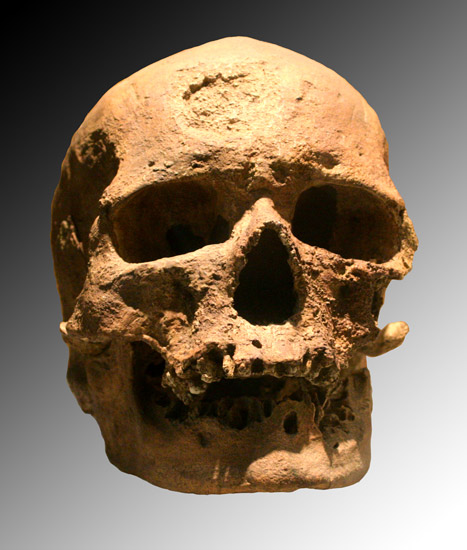
Posted on 01/12/2012 5:17:15 AM PST by Renfield
Paleoanthropologists agree that modern humans evolved in Africa about 200,000 years ago, yet the fossil evidence for the earliest examples of Homo sapiens is scarce. One problem is the difficulty in recognizing true modern humans in the fossil record: At this time, many of the fossils thought to be early members of our species possess a mix of modern and primitive traits. For some paleoanthropologists, it means our species once had a greater range of physical variation than we do today. For others, it means more than one species of Homo may have lived in Africa at this time, sharing some traits in common.
Despite the challenges of identifying early humans, there are several candidates for the earliest known members of our species. Here’s a look at some of the top contenders.
Omo I and II (195,000 years ago): In 1967, a team led by Richard Leakey discovered possible Homo sapiens fossils in the Kibish Formation near the Omo River in southern Ethiopia. Originally the fossils, Omo I (a partial skull and skeleton) and Omo II (a partial skull), were thought to be 130,000 years old, but a dating reanalysis in 2005 revealed they were much older—195,000 years old, making them the oldest fossils assigned to Homo sapiens. Over the last 45 years, the species status of the fossils has been debated. Researchers largely agree Omo I was a modern human; it had the human hallmarks of a flat face, fully formed chin, high forehead and globular braincase. They are less certain about Omo II, which was more primitive with its thicker, more “rugged” cranial bones and sloped forehead. While some paleoanthropologists say Omo II is too archaic to be one of us, others suggest it’s evidence of the great physical diversity of early modern humans.
Herto fossils (160,000 years ago): Tim White of the University of California at Berkeley and colleagues unearthed three largely complete skulls, two adults and one child, in the Middle Awash region of Ethiopia in 1997. The skulls appear quite modern, the researchers reported in Nature in 2003. But because certain cranial traits are outside the range of modern human variation, the researchers placed the Herto fossils in their own subspecies, Homo sapiens idaltu (idaltu means “elder” in the Afar language of Ethiopia). Cutting and scraping marks on the skulls suggest these early humans engaged in some sort of mortuary practices, as these types of markings are not typical of cannibalism.
Qafzeh and Skhul fossils (~100,000 years ago): In the 1930s, researchers working in the caves of Qafzeh and Skhul in northern Israel found the skeletal remains of at least 30 individuals, a few purposefully buried. Some researchers suggest the fossils represent an early migration of humans out of Africa. But like Omo II, some of the fossils in the collection are difficult to classify. For example, the skull known as Skhul V had thick brow ridges and lacked a chin. The primitive traits in this population might have been the result of interbreeding with Neanderthals, which also lived in the region at this time.
Cro-Magnon 1 (30,000 years ago): OK, this fossil is too young to be a real contender for the oldest member of our species. But I included it on the list for its historical significance. Discovered in France in 1868, the Cro-Magnon 1 skull was one of the first ancient Homo sapiens fossils ever found, demonstrating our species’ great antiquity.

Ping
“I coulda been a contenda”.
It was probably so gradual they’ll never pinpoint it. Rather like there aren’t really clear boundaries between races.

“Hominid” of the month contest.
It would help if they discussed brain volume as determinative of human categorization.
.
I don’t care how African they were, NONE of them would qualify for the NBA ~ just too short.
The problem with brain volume is that it’s only one attribute amongst many that seems to constantly vary with these proposed ancestors of man. If you look at all the key traits together, there’s no clear progression at all. So, if you arrange your hereditary tree based on brain volume, then examine another trait, such as the tooth arrangement, or ability to walk upright, you will find that your tree is out of order with regards to those other traits.

I think you make my point for me.
If you through out all “proposed ancestors of man” with insufficient brain volume, you eliminate a lot of “proposed ancestors”.
ya...it upsets a lot of apple carts, but tough!
I think you make my point for me.
If you throw out all “proposed ancestors of man” with insufficient brain volume, you eliminate a lot of “proposed ancestors”.
ya...it upsets a lot of apple carts, but tough!
did we used to have tusk?
It is like trying to pinpoint the exact location your walk through the forest became a walk through the swamp. There was no line, the forest just gradually becomes more and more swampy until you are no longer in a ‘swampy forest’ but more in a ‘foresty swamp’ and eventually - all swamp.
Looking for an exact line of demarcation, looking at your footprints and saying “this step was in a forest, but this step was in a swamp” - is sort of silly - but people like things to fit into neat little boxes, despite this often being inapplicable to reality.
“Omo I and II (195,000 years ago)”
Obviously this whole article is part of the Omo agenda.
|
|
|
| GGG managers are SunkenCiv, StayAt HomeMother & Ernest_at_the_Beach | |

|
|
Thanks Renfield. I'll be hiding behind the chair if anyone needs anything. |
|
|
|
|
If they declare the earliest Homo Sapien, what then? Who was his mate....or hers?
Reading this I remembered my walk through the Koch brothers evolution exhibit at the Smithsonian. Near the end of a large string of skulls showing the gradual changes over 6 million years was a 12,000 year old skull classified as a homo sapien. I looked at this and said to myself, absolutely no way. It didn’t even look like Neanderthal. In fact it looked most like Heidelburgensis which died out much earlier than Neanderthal and was probably a precursor.
These “robust” skulls were from a site, Kow Marsh, in Australia, and have really fouled up the anthropoligical arguments in that continent. My theory, these were a Heidelburgensis remnant of people on the Australian continent from many, many thousands of years ago (perhaps from the low water period of the previous ice age, not our more recent one). The link below carries some of this argument, and also has a detailed theory as to why we have 1 to 4% Neanderthal genes, but no Neanderthal mitochondria, whereas the Neanderthal thus far studied (admittedly very few specimens) have no homo sapien genes.
http://www.convictcreations.com/aborigines/prehistory.htm
Disclaimer: Opinions posted on Free Republic are those of the individual posters and do not necessarily represent the opinion of Free Republic or its management. All materials posted herein are protected by copyright law and the exemption for fair use of copyrighted works.